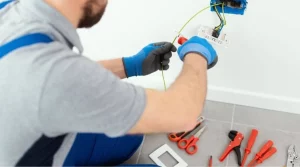As technology integrates further into our living spaces and work environments, safeguarding our remote devices is crucial. With the rise of smart homes and home offices, robust security measures are essential to protect sensitive data and ensure privacy.
From the challenges of remote device usage to the evolving cybersecurity threats, homeowners face complex considerations in securing their digital assets. Discover strategies and tools to bolster effective remote device security, empowering you to combat cyber risks effectively in the digital age.
Key Takeaways
- Utilize strong password management and change default passwords for smart home devices
- Regularly update device firmware to address vulnerabilities and enhance security
- Implement network segmentation and encryption protocols like WPA3 for Wi-Fi networks
- Enable multi-factor authentication and VPNs for added layers of security
Remote Device Security Challenges
In the realm of modern technology and interconnected devices, homeowners are faced with a myriad of remote device security challenges that necessitate vigilant attention and robust solutions. The evolution of smart home devices, ranging from thermostats to security cameras, has introduced vulnerabilities that malicious actors can exploit. One of the primary challenges is the lack of standardized security protocols across various devices, leading to potential weaknesses in the overall network. Additionally, the increasing number of IoT devices connected to home networks creates a larger attack surface for cyber threats.
Furthermore, the complexity of managing multiple devices from different manufacturers poses a challenge in ensuring consistent security measures are in place. Homeowners must navigate through diverse security settings and update procedures, often requiring technical expertise beyond their comfort level. This complexity increases the risk of misconfigurations or overlooked security updates, leaving the network susceptible to breaches.
To address these challenges, homeowners must prioritize security awareness, implement robust authentication methods, regularly update firmware, and segment their networks to contain potential breaches effectively. By staying informed and proactive, homeowners can better safeguard their remote devices and protect their privacy and data.
Importance of Home Network Protection
Utilizing advanced encryption protocols is paramount in safeguarding the integrity of home networks against potential cyber threats. Home network protection plays a crucial role in ensuring the security and privacy of connected devices. Here are three key aspects highlighting the importance of robust home network protection:
- Firewall Configuration: Setting up a firewall helps monitor and control incoming and outgoing network traffic. It acts as a barrier between your devices and potential threats, filtering out malicious data packets and unauthorized access attempts.
- Regular Software Updates: Keeping network devices and routers updated with the latest firmware patches is essential to address vulnerabilities. Outdated software can be exploited by cybercriminals to gain access to your network and compromise sensitive information.
- Strong Password Management: Implementing strong, unique passwords for your Wi-Fi network, router, and connected devices is fundamental in preventing unauthorized access. Avoid using default passwords and consider using password managers to securely store and manage your credentials.

Securing Smart Home Devices
Enhancing the security of smart home devices is a critical component in fortifying overall home network protection against cyber threats. Smart home devices, such as thermostats, security cameras, and smart locks, connect to the internet and can be vulnerable to hacking if not properly secured.
To secure smart home devices, homeowners should start by changing default passwords to complex, unique ones. Regularly updating device firmware is also essential as manufacturers often release patches to fix security vulnerabilities.
Implementing network segmentation by creating a separate network for smart devices can isolate them from personal computers and sensitive information, adding an extra layer of protection. Utilizing encryption protocols like WPA3 for Wi-Fi networks can prevent unauthorized access to smart devices.
Additionally, enabling two-factor authentication whenever possible adds another security barrier against unauthorized access. By following these security measures, homeowners can significantly reduce the risk of cyber-attacks on their smart home devices and safeguard their privacy and data.
Best Practices for Remote Office Security
Implementing robust security protocols is paramount for ensuring the protection of remote office networks against potential cyber threats. To enhance remote office security effectively, consider the following best practices:
- Use Virtual Private Networks (VPNs): VPNs create a secure and encrypted connection for remote workers, safeguarding data transmission from unauthorized access.
- Implement Multi-Factor Authentication (MFA): MFA adds an extra layer of security by requiring users to provide multiple forms of verification before accessing the network, significantly reducing the risk of unauthorized access.
- Regularly Update Software and Security Patches: Ensuring that all devices and software are up to date with the latest security patches helps in addressing any known vulnerabilities that cybercriminals could exploit to breach the network.
Multi-factor Authentication Tips
To fortify remote office security measures further, a crucial aspect to consider is optimizing multi-factor authentication (MFA) protocols. Multi-factor authentication enhances security by requiring users to provide two or more forms of verification before granting access to a system. When implementing MFA, it is essential to choose authentication factors that are diverse and difficult for malicious actors to compromise. Utilizing a combination of something the user knows (like a password), something the user has (such as a smartphone for receiving authentication codes), and something the user is (like a fingerprint or facial recognition) can significantly strengthen the authentication process.
Additionally, it is recommended to enable MFA for all accounts that support it, including email, cloud storage, and financial accounts. This ensures that even if one account is compromised, others remain protected. Regularly reviewing and updating MFA settings, monitoring authentication logs for suspicious activity, and educating users on the importance of MFA are also crucial steps in maintaining a secure remote work environment.
Remote Device Security Tools and Software
Utilizing advanced encryption protocols and intrusion detection systems is essential for fortifying remote device security in a modern digital landscape. When it comes to securing your devices, the following tools and software are crucial:
- Virtual Private Networks (VPNs): VPNs create a secure connection between your device and the internet, encrypting the data transmitted and ensuring anonymity online.
- Antivirus Software: Installing reputable antivirus software helps detect and remove malicious software that could compromise your devices and data security.
- Security Patch Management Tools: These tools assist in automatically updating software applications and operating systems with the latest security patches to address vulnerabilities and enhance protection against cyber threats.
Frequently Asked Questions
What Are Some Common Mistakes Homeowners Make When It Comes to Remote Device Security?
Common mistakes homeowners make in remote device security include weak passwords, neglecting software updates, and overlooking network security. Failure to use encryption or enable two-factor authentication can also expose devices to cyber threats.
How Can Homeowners Ensure Their Home Network Is Properly Protected From Cyber Threats?
Homeowners can ensure their home network’s security by implementing strong passwords, enabling firewalls, updating firmware regularly, using antivirus software, and securing their Wi-Fi network. Regularly monitoring network activity and being cautious with online activities are also crucial.
Are There Specific Steps That Should Be Taken to Secure Smart Home Devices From Potential Security Breaches?
To secure smart home devices from potential security breaches, homeowners should implement measures like updating firmware regularly, using strong passwords, enabling two-factor authentication, segregating IoT devices on a separate network, and monitoring network traffic for any anomalies.
What Are Some Best Practices for Maintaining a Secure Remote Office Environment?
Maintaining a secure remote office environment involves utilizing strong encryption methods, implementing multi-factor authentication, updating software regularly, conducting security audits, and educating employees on cybersecurity best practices. These measures help mitigate risks and safeguard sensitive data.
Can You Provide Tips on How to Effectively Use Multi-Factor Authentication to Enhance Remote Device Security?
Implementing multi-factor authentication is crucial for enhancing remote device security. By requiring users to provide two or more verification factors, such as passwords and biometrics, it significantly reduces the risk of unauthorized access and strengthens overall security measures.
Conclusion
In conclusion, the integration of effective remote device security measures is essential for homeowners in safeguarding their smart homes and home offices. By addressing the challenges, emphasizing the importance of home network protection, securing smart home devices, implementing best practices for remote office security, utilizing multi-factor authentication, and leveraging remote device security tools and software, individuals can enhance their cybersecurity posture and protect their valuable information in today’s interconnected digital landscape.
You May Also Like:






